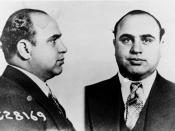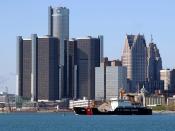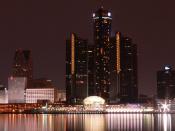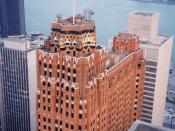THE PURPLE GANG In the late 1920's when I was a young man in East Detroit, I was running errands for the notorious Purple Gang. I started at only 13 and during my time with them, I saw and heard some gruesome things.
Like most other big cities around the turn of the century, Detroit's ghettos were a breeding ground for crime and violence. The Purple Gang's evolution is not much different from a dozen similar stories from any American city. They were really no different than the Five Points Gang in Brooklyn, the North side Gang in Chicago or the Boiler Gang in Philly.
Rumor had it that the gang received its colorful name as the result of a conversation between two Hastings Street shopkeepers. Both of the men's shops had been the targets of the youngster's shoplifting and vandalism. One day in disgust, one of the shopkeepers exclaimed, "these boys are not like other children of their age"ÃÂ.
"Yes"ÃÂ, replied the other shopkeeper, "they're rotten, purple, like the color of bad meat, they're the Purple Gang"ÃÂ.
In the beginning, the gangsters were nothing more than the sons of Russian Jewish immigrants who had come to the new country in search of a better life. But like so many others, the immigrants found life in the United States was not that different and that the streets of Detroit really were not paved in gold.
Now what I would usually do is relay messages from the liquor loaders to the men in the warehouses or trucks. The Detroit River was the prime sight for the Purple's liquor bootlegging. The river represented the boarder between Ontario Canada and the United States. It was and probably still is one of the busiest waterways in the world. I remember the freighters bringing iron ore from Michigan's Upper Peninsula to the bustling automobile factories of our Motor City. Timber barges from Northern Michigan and Wisconsin, pass through the narrow waterway which separates Windsor and Detroit in route to Lake Erie and the East Coast. Hordes of recreational boaters and weekend fishermen use the river for their pleasure.
The Purple's got their uses from the river in the winter. You see, in the winter, traffic on the narrow flow comes to a halt as the river freezes over.
During this time, rumrunners and bootleggers used the frozen river as an easy way to get booze from Canada into the United States. From Detroit, liquor went to Chicago, where Capone sold it under his "log cabin"ÃÂ logo, St. Louis and points west.
It was a well known fact that if you were bringing a load of hooch across the Detroit River that you had better show up armed to the teeth, because in the 20's, Detroit belonged to the Purple Gang. They were a group of killers and thugs as vicious and blood thirsty as any racketeer in New York or Chicago.
Detroit may not have been New York, but make no mistake; the Purple Gang was tough. They were strong enough to tell Capone to keep his mitts off Eastern Michigan and managed to hold on to control of most of the state when Scarface was at his peak. U.S. 31, which goes through the middle of Grand Rapids and runs from the top of Michigan to the Indiana border, was the territorial line. West of 31 was Capone's territory, but east belonged to the Purple's. Capone coveted Detroit, with it's huge number of hard working, hard drinking laborers, but wisely decided it was better to buy booze from the Purple Gang than to fight them.
Back to me on the river, Now I really don't know what Ben Bronstein had going through his head on the night of January 13th. 1929. Ben was a freelance highjacker that thought it was a good idea to steal a load of Purple Gang liquor. He would soon come to find out that this would be a deadly mistake. The men were just finishing up the last few trucks in the long line to be loaded with liquor when out of nowhere we all heard the rumbling start of one of the front trucks engines. Young Joe Bruce went running for the truck just as it was pulling out. Joe pulled his weapon and fired at the fleeing vehicle. After the shots were fired, I witnessed the truck swerve out of control and hit a nearby tree. One of the bullets fired by Bruce caught Bronstein in the back of the head, hence rendering him from his highjack.
Seeing this shooting at my young age had quite an effect on my life. I learned one thing for sure; you don't mess with the Purple Gang - because in the 30's, Detroit belonged to the Purples.
In conclusion, the Purples ran the rackets in Detroit for much of the 1920's and 1930's until the Syndicate boys from back east moved in and wrestled control from a gang that had seen its numbers decimated by prosecution.





